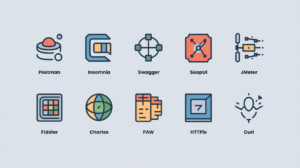 In today’s rapidly evolving digital landscape, “scalability” has become a critical concept in web development discussions. But what exactly does application scalability mean?
In today’s rapidly evolving digital landscape, “scalability” has become a critical concept in web development discussions. But what exactly does application scalability mean?
What is Application Scalability?
Application scalability is a web app’s ability to handle growing demand efficiently, adapting its resources to maintain performance and a smooth user experience. For instance, scalable apps can manage increased workloads, like high traffic, with positive user experience and resource optimization, leading to cost savings and a higher chance of significant ROI.
Focusing on creating scalable web applications helps businesses position themselves for success, ensuring they can meet current demands while being prepared for future growth. Scalability has transcended its technical roots to become a strategic business imperative.
The Advantages of a Scalable Web Application
Scalability is the backbone of a web application’s ability to thrive in a dynamic environment. Here are some of its advantages:
- Uninterrupted Service: Whether you’re a startup experiencing unexpected growth or an established platform facing seasonal traffic spikes, scalability ensures your application remains accessible and operational. According to a survey by Datado, 73% of developers identified scalability as a critical factor for their applications.
- Cost-Effectiveness: Scalability allows you to optimize resource allocation. Instead of substantial upfront investments in massive infrastructure, you can scale your resources as your needs evolve. For instance, a study found that using cloud-based software services with effective scalability can lead to a reduction in operational costs by up to 70%, as it allows for precise scaling to match demand, thereby avoiding unnecessary expenses.
Enhanced User Experience: No one appreciates a slow, unresponsive website. Scalability guarantees faster loading times and a smooth user experience, keeping your customers engaged and satisfied. For example, Zoom’s exponential revenue hike — from $623 million in 2020 to $4.10 billion in 2022 — underscores scalability’s sheer impact on growth
The Two Pillars of Scalability: Vertical vs. Horizontal Scaling
In scalable web applications, two primary strategies reign supreme: vertical scaling and horizontal scaling. These approaches, although distinct, play pivotal roles in defining how an application can accommodate growth.
-
Vertical Scaling (Scaling Up):
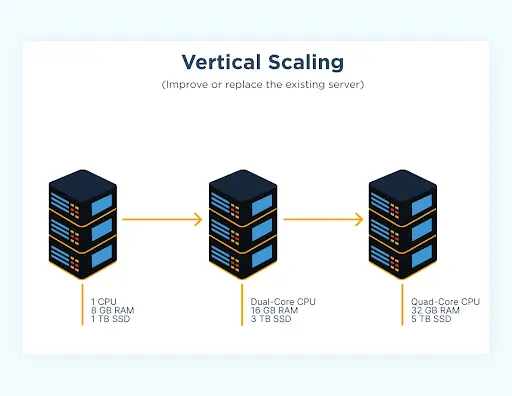
Vertical scaling, often referred to as “scaling up,” involves enhancing the capabilities of a single server or resource. Essentially, vertical scaling refers to adding more power to your existing hardware. This could mean upgrading a server with a faster CPU, more RAM, or additional storage. It’s akin to upgrading your personal computer with a higher-end processor or adding more memory to handle resource-intensive tasks more efficiently.
-
Horizontal Scaling (Scaling Out):
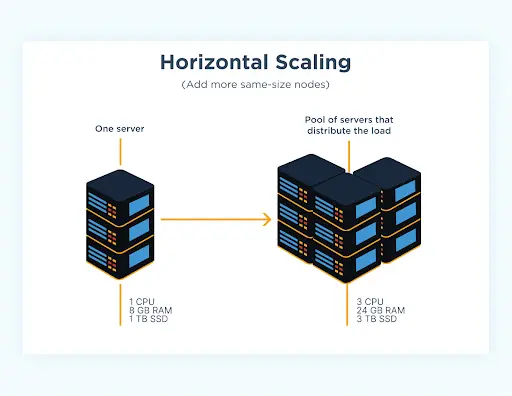
On the other side of the spectrum is horizontal scaling, sometimes called “scaling out.” In layman’s terms, horizontal scaling refers to adding more servers or resources that run in tandem, distributing the load amongst them. Instead of making one machine more powerful, you’re adding more machines to your pool of resources. The fundamental principle here is that multiple servers, often orchestrated by load balancers, handle incoming requests, ensuring no single server becomes overwhelmed.
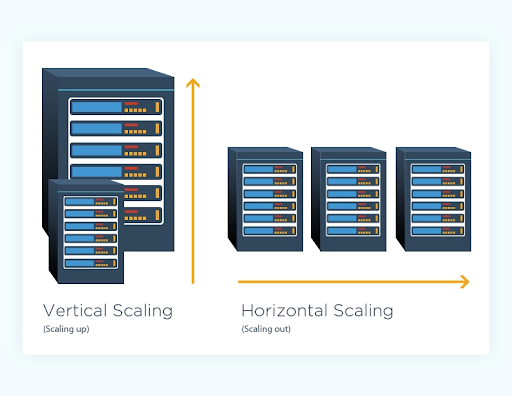
While both vertical and horizontal scaling have their merits, the ideal solution often combines both. Integrating vertical and horizontal scaling helps organizations build a robust infrastructure that can adapt to varying loads, optimizing performance and cost efficiency.
This is where partnering with a development team like 42Works can be invaluable. 42Works’ expertise in designing and building scalable web applications ensures your platform can seamlessly handle growth, allowing you to focus on what matters most – your business goals.
Factors That Influence the Scalability of a Web App
Scalability isn’t achieved merely by adding more resources. Multiple factors influence how effectively a web application scales, ensuring optimal performance as demand grows. Here’s a closer look at some of these factors:
- Architectural Pattern: The architectural pattern you select can profoundly influence the system’s capabilities. A study by O’Reilly revealed that 77% of businesses have adopted microservices, with 92% reporting successful outcomes.
- Database Server: Distributed databases can offer redundancy and up to 99.999% uptime, which translates to almost zero downtime.
- Infrastructure and Architecture: Cloud services provide on-demand resources, which can lead to up to 30% savings on infrastructure costs compared to traditional on-premise solutions.
- Web Design Technologies: Efficient coding and user interface optimization can significantly reduce server load, with link optimization services potentially cutting down unnecessary data transfer by up to 70%.
- Server Load Balancing: Load balancers can indeed improve application performance by an average of 40% by distributing traffic evenly across servers
- Third-Party Services: Integrating third-party services can offload specific tasks from your main application. For example, instead of building a proprietary payment system, integrating a third-party payment gateway can save resources while ensuring scalability.
Optimizing these influencing factors is like solving a jigsaw puzzle. Each piece – from the architecture pattern to the user interface – needs to fit perfectly. Understanding and optimizing these factors helps businesses ensure their web applications are poised for both current demands and future growth.
Principles and Steps for Developing Scalable Applications
As the digital ecosystem evolves, designing scalable web applications has become paramount for businesses aiming for long-term sustainability. The foundational step in this journey is understanding and implementing core scalability design principles.
- Scalable Architecture: At the heart of any scalable system is its architecture, designed to handle growth and varying loads. Microservices architecture breaks down the application into independent services, allowing separate development, scalability, and maintenance.
- Scalable Front-End: The scalable app architecture also extends to the front end. Ensuring that user interfaces are lightweight, efficient, and can adapt to various devices and screen sizes is crucial.
- Scalable Development Practices: Scalable web app principles encompass technical aspects and best practices like regular performance audits, ensuring code modularity, and making forward-compatible decisions anticipating future technological trends.
How To Create a Scalable Web Application?
Building a scalable web application is a journey, not a destination. It involves various stages, from ideation to deployment, each requiring careful consideration. Here’s a breakdown of the process:
- Foundation: Before you even start to build, it’s vital to lay a strong foundation. This means selecting the right tools, technologies, and platforms that align with your scalability goals. A part of this is assessing any existing web app and determining if it meets the scalability criteria or if modifications are required.
- Modular Design: Embrace a modular design to ensure that different application components can scale independently. This approach simplifies server maintenance and allows for more flexibility in allocating resources.
- Optimized Development: Web app development should be approached with performance in mind. This means writing efficient code, minimizing resource-intensive operations, and regularly profiling the application to identify and rectify bottlenecks. For example, in a modern language like Python, a simple code snippet for caching might look like this:
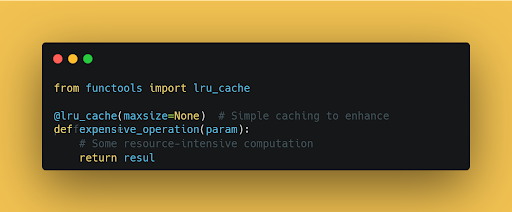 This small addition can drastically improve performance by storing the results of expensive computations and reusing them when required.
This small addition can drastically improve performance by storing the results of expensive computations and reusing them when required. - Regular Audits: Just because your application is scalable now doesn’t mean it will remain so in the future. Regularly auditing your application, assessing server loads, and monitoring resource utilization will ensure the app remains optimized as it grows.
- Stay Updated: Technologies and best practices constantly evolve. Staying updated with the latest scalable development trends ensures your application remains future-proof. Here are a few ways to stay ahead of the curve:
- Follow industry publications and blogs
- Attend conferences and workshops
- Explore online courses and tutorials
- Hire Expertise
- Feedback Loop
Creating a scalable web app is a meticulous process, but the payoffs in performance, user satisfaction, and business growth are immense. With the correct principles in place and a systematic approach to development, any business can ensure that its digital offerings are poised to handle the challenges of today and the opportunities of tomorrow.
Challenges and Real-world Examples
Scaling a web application means ensuring it can handle many users or vast amounts of data while maintaining consistent performance, security, and a seamless user experience. Let’s delve into some common challenges in web application development and how they can be addressed using practical JavaScript solutions:
Challenge #1: Integration with Third-Party Services
Challenge: Integrating third-party services, like payment gateways or analytics tools, can sometimes slow down a web app. There’s also the risk of these services becoming unavailable, impacting your application’s functionality.
Solution: Utilize asynchronous calls to avoid blocking the main thread while waiting for responses from third-party services. Here’s an example of an asynchronous call using the Fetch API:
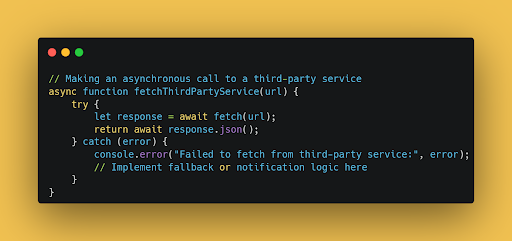
Challenge #2: Maintaining a Scalable Website
Challenge: As traffic grows, a scalable website might suffer from performance bottlenecks, especially if not optimized for scalability.
Solution: Implement caching mechanisms to store frequently accessed data on the client side, reducing the load on the server. Here’s an example using LocalStorage for simple client-side caching:
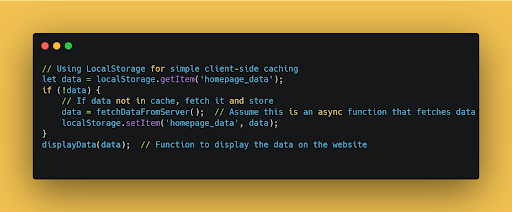
Challenge #3: Microservices Architecture Challenges
Challenge: While microservices architecture benefits scalability, it can introduce service communication and data consistency complexities.
Solution: Utilize asynchronous calls between microservices using the Fetch API to manage communication effectively. Here’s an example:
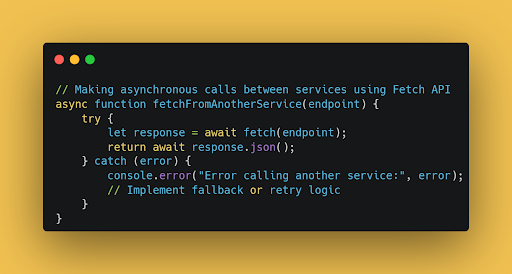
Challenge #4: Handling Varying Loads Across Web Applications
Challenge: With multiple web applications running on a server, ensuring each app gets the required resources without affecting others can be challenging.
Solution: Implement basic client-side rate limiting to prevent overwhelming the server with requests. Here’s an example using timestamps:

Challenge #5. High Availability for Scalable Apps
Challenge: Traffic spikes can cripple large web apps. How do we ensure they stay available?
Solution: Implement a retry mechanism for failed requests. This code snippet demonstrates retrying a failing API call up to 3 times before giving up.
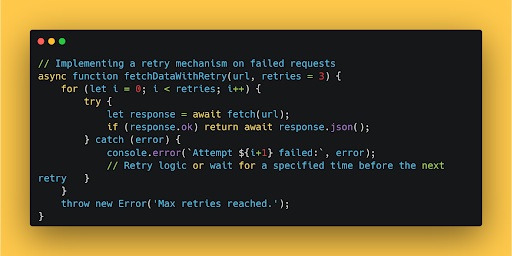
With these challenges addressed, the next section will explore real examples of businesses that overcame scalability hurdles to achieve remarkable growth.
Real-World Examples
Netflix:
- Challenge: Transitioning from a DVD rental model to streaming created massive scalability issues.
- Solution: Adopted a microservices architecture, breaking the monolithic application into smaller, manageable services. This improved scalability and allowed for faster, more reliable feature deployments.
Twitter:
- Challenge: Frequent downtimes, especially during peak usage, plagued their monolithic Ruby on Rails application.
- Solution: Migrated to a more scalable system using Scala and a distributed database. This ensured smooth performance even during high-traffic events.
Pokémon Go:
- Challenge: Unexpected popularity overwhelmed servers, causing outages and slowdowns at launch.
- Solution: Niantic, the developer, rapidly scaled infrastructure by partnering with Google Cloud to handle the vast number of players.
Conclusion
Building scalable web applications is an ongoing process that requires careful planning, informed decisions, and continuous monitoring.
By understanding core scalability principles, implementing best practices, and adapting to evolving technologies, businesses can ensure their web applications are equipped to handle present and future demands, fostering growth and success in the ever-expanding digital landscape.
We hope this comprehensive blog provides valuable insights into the world of scalable web applications. If you’re looking to build a scalable web application or enhance the scalability of your existing platform, 42Works is here to help. We offer a range of development services and expertise to guide you through every step of the process. Explore our web application portfolio today!
Feel free to reach out to us today!
[author_details]
